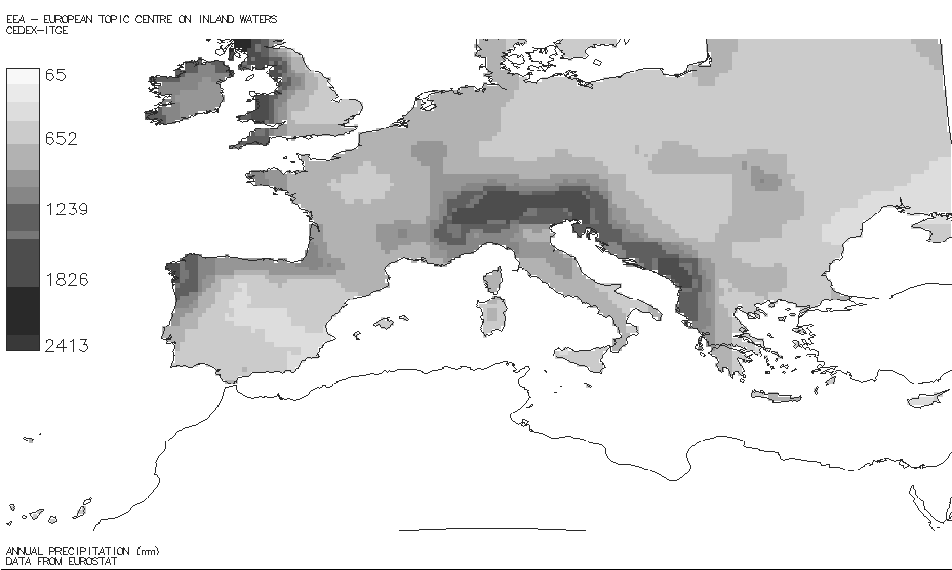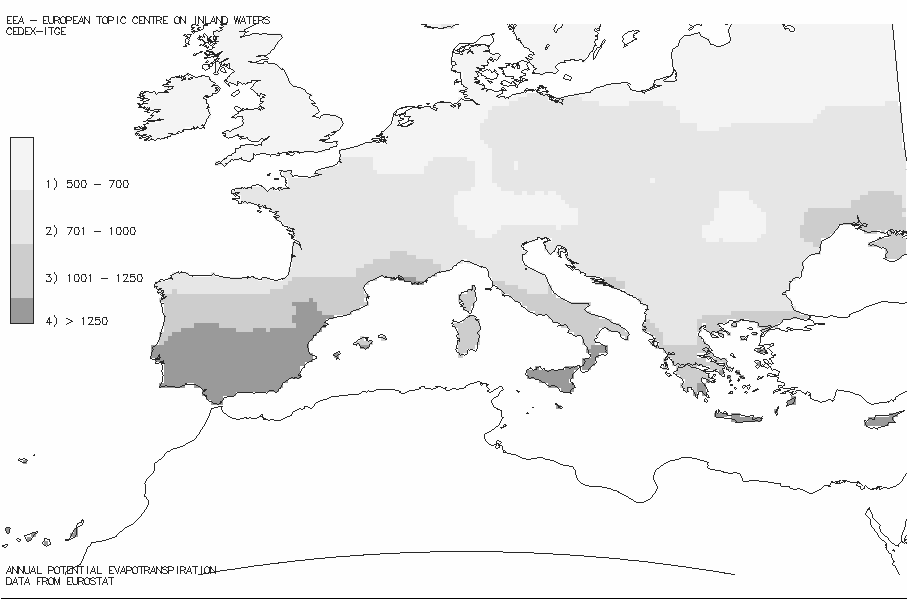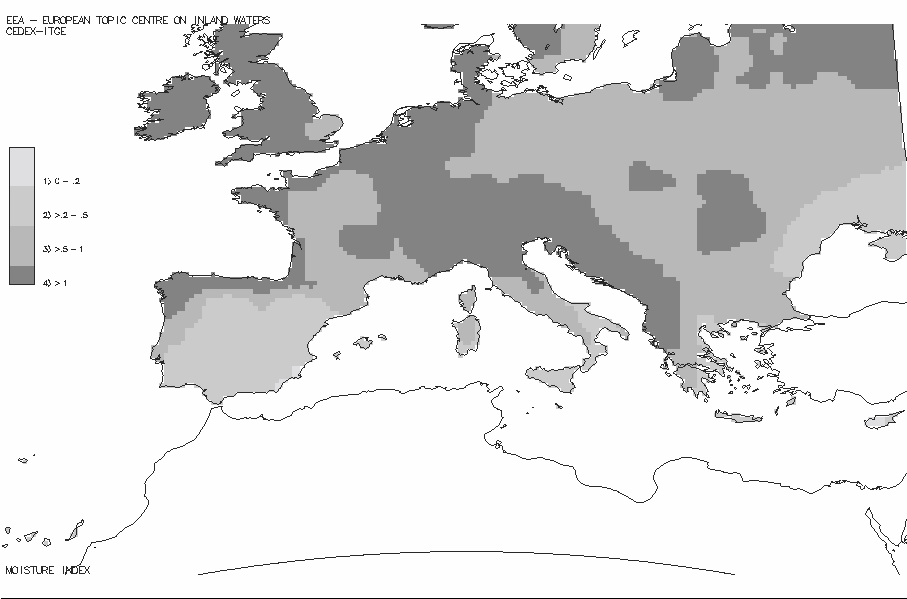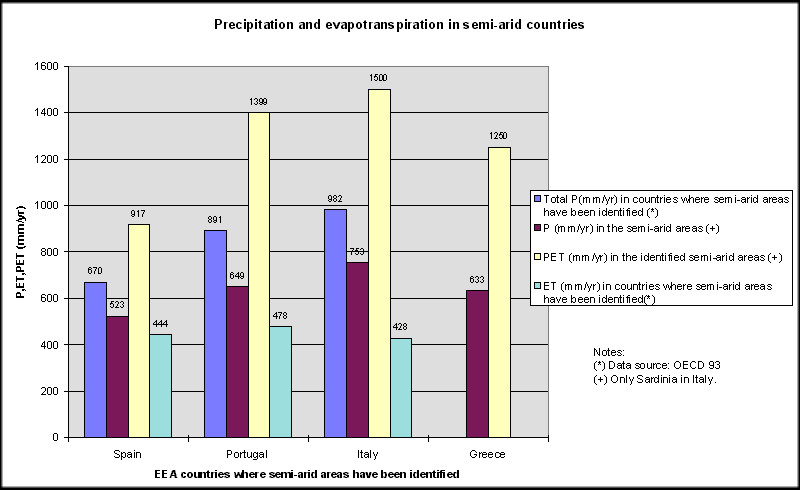2.
Semi-Arid Areas in the EEA Area
A climatic zoning, which is based on
the moisture index Ih -, (also known as the UNESCO index), has been established
with a view to obtaining insight into the problems associated with water resources in the
semi-arid areas of the European Environment Agency (EEA). This index, Ih, is
obtained as P/PET, where P is the average annual precipitation, and PET is the potential
evapotranspiration according to Penman's formula.
In 1979, UNESCO prepared the World
Map of Arid Zones (UNESCO, 1979). Four classes or degrees of aridity were considered,
these corresponding to the great geographical categories that are generally accepted.
These were:
Hyper-arid zones (P/PET <
0.03). Deserts in the strict sense of the term.
Arid zones (0.03 £ P/PET <
0.20). Sub-deserts or semi-deserts.
Semi-arid zones (0.20 £ P/PET
< 0.5). Steppes, prairies, certain types of savannah and a large part of the
Mediterranean vegetation. These are zones whose precipitation varies greatly from year to
year.
Sub-humid zones (0.5 £ P/PET <
0.75). The limits between these zones and the wet and semi-arid zones, are highly
changeable and subject to fluctuations.
The precipitation (Figure 2.1-1) and
average annual potential evapotranspiration maps (Figure 2.1-2), have been taken from the
UNESCO publication entitled "Atlas of World
Water Balance" (UNESCO, 1977).
Figure 2.1-3 shows a map of Europe after the four
classifications mentioned above have been applied, and it can be seen that the following
EEA regions fall into the semi-arid category: South of Portugal, South East Spain and
parts of the central area, South East Italy plus Sardinia and Sicily and South East
Greece.
Sections 2.1 and 2.2. are focused on
the hydrological characteristics: precipitation, evapotranspiration, and runoff, in
semi-arid EEA areas. The information has mainly been taken from the UNESCO publication
"Comparative Hydrology" by Falkenmark and Chapman (1989), and has been
supplemented with more detailed information concerning the semi-arid regions of Spain and
Portugal.
2.1. Precipitation and
Evapotranspiration
The average annual precipitation in
semi-arid regions is well below the annual potential evapotranspiration (P < 0.5 PET).
The values are generally very low, and the completely dry season usually lasts several
months.
A basic feature of precipitation is
the spatial distribution of storms. The surface area covered by storms in semi-arid zones,
especially in the Mediterranean, is often small, and the rainfall decreases sharply within
a short distance of the epicentre of the storm. The intensity of the precipitation is
another relevant factor in flow generation and also in soil erosion. For instance, at
different locations in the Spanish Mediterranean area, over 500 mm have been recorded in
one single day.
The maximum theoretical
evapotranspiration is determined by the potential evapotranspiration, PET. However, in
semi-arid zones, the actual evapotranspiration E is considerably lower than the PET, on
account of the lack of water most of the year. As specific potential evapotranspiration
conditions are absent, it is difficult to estimate E, because a series of other factors
come into play, such as the pattern and magnitude of the precipitation, soil-type and
vegetation cover, etc.
The actual evapotranspiration is
close to zero in the driest regions of the semi-arid zones, where maximal PET values and
negligible rainfall is recorded. The value can be estimated from the water balance.
Several different methods can be used for calculating the potential evapotranspiration,
including the Penman Monteith method, recommended by the FAO in the "Report on the
Expert Consultation on Revision of FAO Methodologies of Crop Water Requirements".
(FAO, 1991).
Figure 2.1.-1 - Precipitation map

Figure 2.1.-2. - Potential
evapotranspiration map

Figure 2.1.-3 - Moisture index
map.

2.1.1. Spain
The rainfall distribution is
extremely uneven, and an approach to the problem by using average statistical values,
could give rise to serious errors. Therefore, although the national average annual
precipitation is about 670 mm (equivalent to 340,000*106 m3/year),
the average is 1,315 mm, in Northern Spain, and 380 mm in the Segura Basin. The average
annual precipitation does not exceed 200 mm in some areas, like Almería in the Sur Basin
(MOPTMA, 1993). There is also a marked annual unevenness in each basin, which brings water
shortages and drought after several consecutive dry years.
The national mean annual PET is
about 800 mm and the actual evapotranspiration 445 mm/year, which amounts to approximately
226,000*106 m3/year.
The Segura Basin is the area whose
mean annual precipitation is considerably lower than it is in the rest of the semi-arid
areas in Spain. This area must face the problems related to water availability for
irrigation year after year. Water supply problems also appear during dry seasons in most
of the areas of the Guadiana, Guadalquivir and Sur Basins. Those basins register an annual
mean precipitation lower than the national average.
Table 2.1- 1 shows the basins
considered, in global terms, as semi-arid regions in Spain (Estrela, T. 1995). A region
has been considered as a semi-arid one when a high percentage of its surface area complies
with the UNESCO moisture index criterion for semi-arid areas (P/PET £ 0.5).
2.1.2. Portugal
The mean annual precipitation (P) in
Portugal is 889 mm (OECD, 93). There is an imbalance between the northern and southern
basins: whilst P=1,800 mm or even more (2,373 mm/year in Cavado basin) in the north; while
in the south, the Sado and Mira Basins have P values around 700 mm or even less in the
Guadiana Basin.
In Portugal, there are 5 regions
with semi-arid or scarcity issues (INAG, 1995b), as Table 2.1-1 shows. Region 1 is the
part of the Douro catchment with Mediterranean climate (located in the North). Regions 3
and 4 are the must problematic zones in terms of scarcity, both in surface and
groundwater. In these regions there are problems of domestic water supply. The figures
corresponding to P/PET are slightly greater or equal to 0.5 in the Alto Douro (01), Soul
Tejo (02) and Sado e Mira (03) , yet they are less than 0.5 in the Guadiana basin and in
the Algarve region. Although in the Guadiana basin the PET is equal to 1,304 mm/year, the
precipitation is the lowest in the Portuguese catchment areas. In Algarve, the mean annual
precipitation is equal to 653 mm, but the PET is the highest (equal to 1689 mm/year).
The PET figures quoted here seem to
have been estimated in a different way from those in Spain.
2.1.3. Italy
The mean annual precipitation in
Italy is P=982 mm (OECD 93). The island of Sardinia (24,000 km2) in Italy has a
climate characterised by a water deficit at most altitudes. The mean annual precipitation
is 752.8 mm and the mean annual potential evapotranspiration is roughly 1,500 mm
(Environment Department, 1995)
2.1.4. Greece
Greece is divided into fourteen
hydrologic departments. Two of them, Attiki and the Aegean Islands, are areas with water
scarcity problems, due to the unfavourable hydrogeology and the low precipitation. The
high population density in Attiki is another particularly remarkable factor (almost 35% of
the total population in Greece is concentrated in Athens). There are also water scarcity
problems in East Peloponnisos and in some particular areas of Central Macedonia, as Table
2.1-1 shows. The Aegean Islands region is the driest in Greece, having a mean annual
precipitation of 500 mm and the potential evapotranspiration is equal to 1250 mm/year.
Table 2.1. -1 Semi-arid regions
in the EEA area.
Country |
Region name |
Region number |
P (mm/year) |
PET (mm/year) |
P/PET |
Greece |
Aegean Islands
Attiki
North Peloponnisos
East Peloponnisos
Central Macedonia
Kriti |
14
06
02
03
10
13 |
500
900
800
600
600
900 |
1250
1250
1250
1250
1250
1250 |
0.40
0.72
0.64
0.48
0.48
0.72 |
Portugal(*) |
Alto Douro (18,710a )
Sul Tejo (24,860 b)
Guadiana (11,700)
Sado e Mira (9,236)
Algarve (4,048) |
01
02
03
04
05 |
683
687
564
659
653 |
1293
1381
1304
1327
1689 |
0.53
0.50
0.43
0.50
0.39 |
Italy (+*) |
Sardinia (24,000) |
|
753 |
1500 |
0.50 |
Spain (*) |
Guadiana (60,000)
Guadalquivir (63,500)
Sur (18,000)
Segura (18.800)
Jucar (42,200) |
04
05
06
07
08 |
557
617
539
381
520 |
933
951
985
912
802 |
0.60
0.65
0.55
0.42
0.65 |
Notes:
P (mm/year) is the mean
annual precipitation.
PET (mm/year) is the mean annual evapotranspiration.
(*) Figures in brackets state the catchment surface (km2)
(+) Only information from Sardinia.
(a) Total surface area of Portuguese Douro basin.
(b) Total surface area of Portuguese Tejo basin.
The value of mean annual potential
evapotranspiration in Spanish semi-arid areas is PET= 950 mm/year on average, whilst,
those are greater than or equal to 1500 mm/year in Portugal (Algarve), Greece and
Sardinia. However, Figure 2.1-4 shows a comparison of the values of the registered
evapotranspiration, which are similar in the semi-arid countries. Studies at a European
scale would be necessary in order to establish commonalities between the semi-arid regions
in the EEA area.

Figure 2.1.-4 Precipitation and
evapotranspiration in semi-arid countries.
2.2. Runoff
The discharge hydrograph is closely
related to the temporal precipitation distribution. The precipitation characteristics
mentioned in Section 2.1 make flash floods be a common feature in semi-arid zones.
Droughts are a consequence of the
variability in river runoff from year to year. Although they tend to affect large parts of
Europe at the same time, they are particularly damaging in semi-arid areas, like the one
which has affected southern Spain during these last years.
Aquifer recharge in semi-arid zones
is lower than in wet areas, not only because the precipitation is lower, but also as a
result of the uneven temporal distribution of this precipitation. During most of the year,
the soil is not saturated, and this makes aquifer recharge difficult not only in summer
months, but sometimes even in winter. The use of groundwater, either in conjunction with
surface water or independently, is of vital importance in these zones when attempting to
alleviate the effects of drought.
Part of the water that recharges the
aquifers eventually reaches the surface drainage network, and is one of the basic
constituents of the total yield. It is of paramount importance to have in-depth knowledge
of the processes and laws of exchange which govern the river-aquifer relationship in such
zones. An awareness of this information would serve to evaluate, for example, the effects
of aquifer extraction on the discharges of the rivers.
2.2.1. Spain
The total average annual yield
(surface water and groundwater) is 114,000*106 m3, which amounts to
specific runoff figures of 230 mm/year. The European average is approximately 300 mm/year.
However, only a small amount of the natural resources are directly useable, roughly
9,200*106 m3 per year, which is a mere 8 % of the total on the
Spanish peninsular. This figure contrasts sharply with the European average, where the
percentage is 40% of the natural resource (MOPTMA, 1993).
From a comparative viewpoint, this
situation is even less satisfactory when the uneven space/time distribution is taken into
account. The basins in Galicia and in the North, which have a surface area of 53,800 km2
(10.6 % of the national territory), provide an average annual figure of 42,000*106
m3 (36.3 % of the national average). Two basins in the South, the Segura and
the Júcar, with a total surface area of 79,830 km2 (15.8 %) yield an annual
average of 7,600*106 m3 (6.6 % of the total). That is to say, there
is an 8:1 relationship in the yields per unit of surface area.
2.2.2. Portugal
The total surface of the Portuguese
catchment areas is 89,300 km2 . Five rivers are transboundary and the total
surface of the shared basins between Spain and Portugal is 268,529 km2. The
total specific runoff (Spain and Portugal) is 295 mm/year, and the figures for Portugal
are 313 mm/year and 287 mm/year for the runoff coming from Spain. (LNEC, 1992).
There is also an imbalance between
the northern and the southern basins. The Minho catchment area is 17,081 km2
(5% of the surface is Portuguese) and its average total runoff is 750 mm/year; whilst in
the Guadiana basin (71,573 km2 , 16.3% of this surface is Portuguese) the total
runoff is only 90 mm/year (188 mm/year yield in Portugal), (LNEC, 1992).
2.2.3. Italy and Greece
The average specific runoff in Italy
is 554 mm/year, which is a much higher figure than the European average, and it represents
a total quantity of internal resources of 167,000 *106 m3 (OECD
1993). Despite these figures, Sardinia and Sicily are stated as semi-arid regions, which
demonstrate once more the imbalance between basins in Italy.
The internal resources of Greece are
45,000*106 m3 (OECD,1992), which are equivalent to an average runoff
of 341 mm/year. The areas having scarcity problems are located mainly in the southern
regions of the country.





Document Actions
Share with others